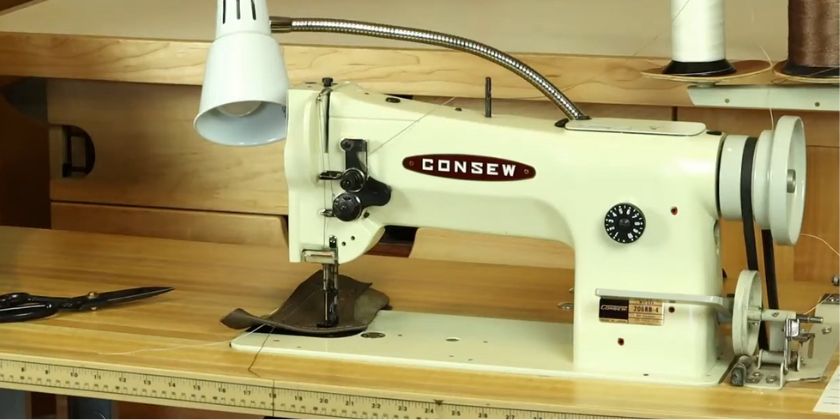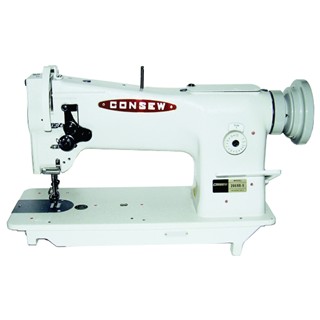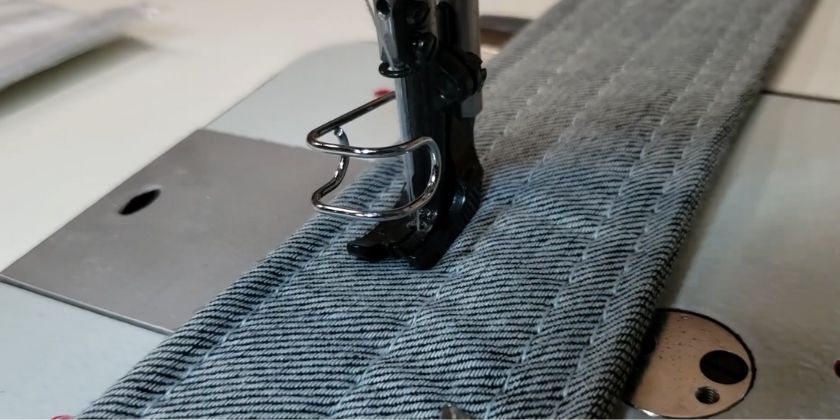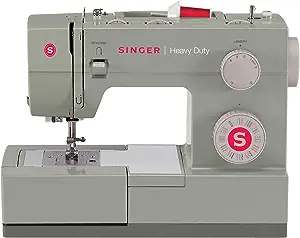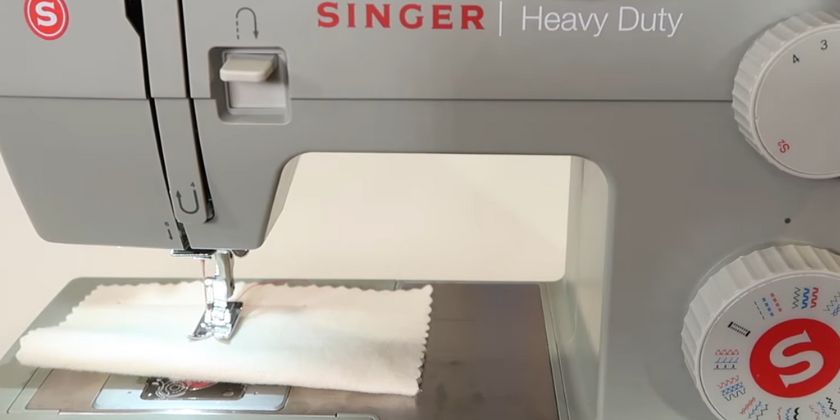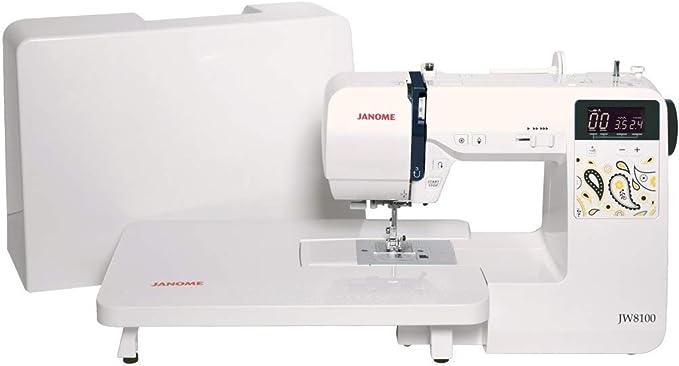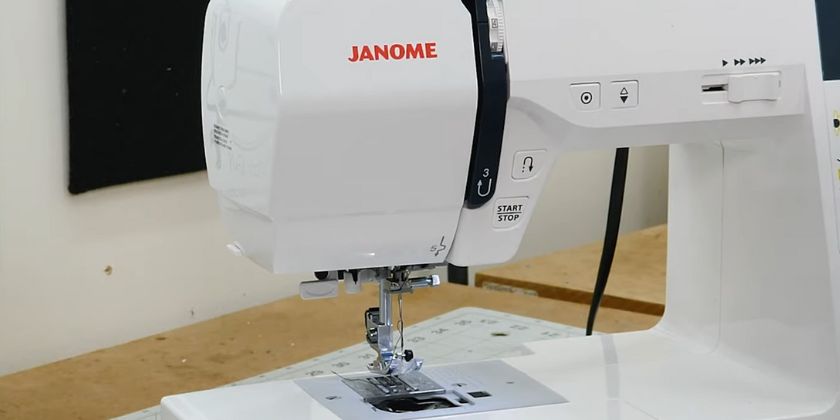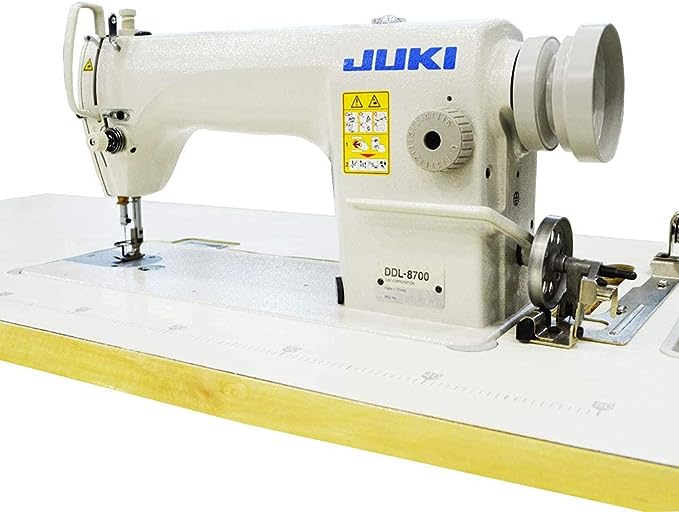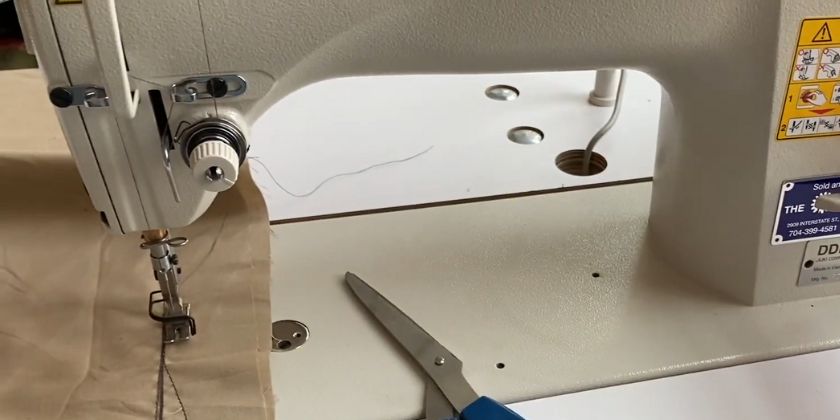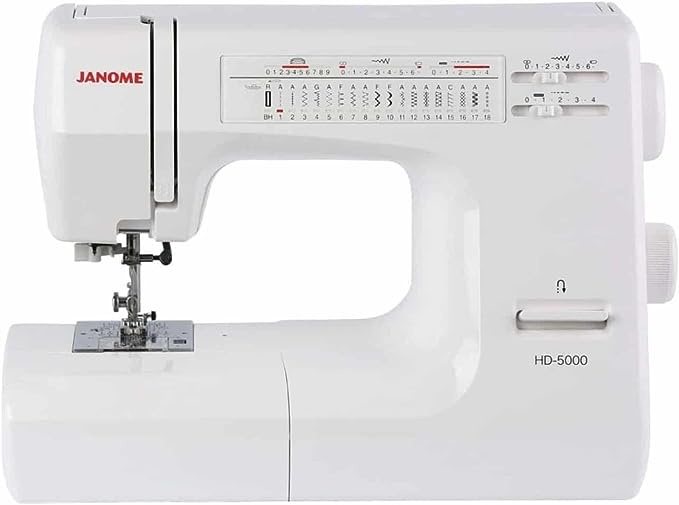In my two decades of experience in upholstery, I’ve seen all sorts of sewing machines tackle car interiors. After testing numerous models, the Consew 206RB-5 stands out as the absolute best for auto upholstery. It’s a powerhouse that conquers thick materials and tricky seams with ease.
But fear not, there’s a perfect machine for every upholsterer! Whether you’re a budget-conscious beginner or a tech-savvy pro, I’ve got you covered.
Deciding on the best auto upholstery machine depends on your experience level, project needs, and budget. Don’t worry, I’ll break down the key features and buying considerations for each option. Keep reading to discover your ideal match for creating stunning, long-lasting car interiors!
Top 5 Best Sewing Machines For Auto Upholstery, Tested
- Our Top 5 Picks Tested and Reviewed
- 1. Consew 206RB-5 – Best Sewing Machine For Auto Upholstery
- 2. SINGER 4452 – Best Beginning-Friendly Sewing Machine For Auto Upholstery
- 3. Janome JW8100 – Best Computerized Sewing Machine For Auto Upholstery
- 4. Juki DDL-8700 – Best High-Speed Sewing Machine For Auto Upholstery
- 5. Janome HD5000 – Best Heavy-Duty Upholstery Sewing Machine
- Things to Consider In An Auto Upholstery Sewing Machine
- FAQs
1. Consew 206RB-5 – Best Sewing Machine For Auto Upholstery
Our #1 Pick
- 3300 stitches/minute speed
- 178mm x 480mm bed size
- 161 lbs weight
- 10mm max stitch length
It’s a walking Foot Industrial Sewing Machine that is incredibly powerful for any sewing needs. With an impressive 3300 stitches per minute and unmatched accuracy, you will surely get the job done quickly.
Although it has many flagship features, the compound feet walking foot, locking stitch regulator, and large bobbin are my favorite.
For those who don’t know, the Compound Feed Walking Foot reduces the slippage and gives you an evenly-stitched seam at high speeds.
Similarly, the locking stitch regulator ensures that the stitch length remains uniform, even when the machine vibrates. At the same time, the M-style large-capacity bobbin will last for many sewing cycles and minimize bobbin reloading time.
The Consew 206RB-5 is built with user convenience in mind. This is made evidently clear by the servo motor that allows you to control the speed and an adjustable knee lifter for faster operation and decreased user fatigue.
Its bed is 7×18-7/8 inches and offers a workspace of 10-5/16×4-1/4 inches with a maximum stitch length of 10 mm.
Plus, the additional accessories like the extra slotted needle plate, finger guard, double head 101mm wrench, 6×7 mm spanner, and bobbin winder will ensure you have everything to get started immediately!
Although we’ve tested it primarily for auto upholstery, you can also use this sewing machine for other uses, such as sporting goods, tents, sails, luggage, etc.
Pros
- Full rotary hook for industrial strength stitching
- High-power motor that can handle thick and heavy fabrics with ease.
- Durable construction that is built to last a long time
- Built-in thread cutter and bobbin winder make the setup process much easier.
- Reverse stitching capabilities allow you to reinforce the stitches on your project
Cons
- Difficult to set up for the first time.
- Heavy and bulky – not easy to move around or transport
- Not easy for beginners
- Expensive compared to similar machines on the market
I used to own a Consew sewing machine with a large 3/4 horsepower motor, but the newer model has a smaller motor with the same amount of power. It’s quite impressive. As mentioned by others, there were no setup instructions included. Fortunately, there are helpful videos on YouTube posted by users. However, some of the instructions may not be accurate, so proceed with caution. If you’re handy with mechanical work, you should be able to figure it out. Otherwise, I recommend seeking assistance from a professional. I’ve heard that Consew shifted their manufacturing to China some time ago, but the product still seems solid. Overall, I’m very satisfied with my purchase so far.
- Top 5 Best Sewing Machines for Leather (Updated)
- Top 5 Best Sewing Machine For Denim (Updated)
- Large throat Sewing machines for Quilting, Tested & Reviewed – Our Top 5 Picks for 2024
2. SINGER 4452 – Best Beginning-Friendly Sewing Machine For Auto Upholstery
Beginner-Friendly Pick
- 1100 stitches/minute speed
- 4mm max stitch length
- 15.5″ x 6.25″ x 12″ Dimensions
- 14.6 lbs weight
Many complain about the sewing machines being too complicated – especially for beginners. Therefore, our next pick, the Singer 4452, is a midrange, beginner-friendly sewing machine.
With a heavy-duty metal frame, it’s as sturdy and reliable as they come.
You get 32 built-in stitches, including 6 basic, 7 stretch, and 18 decorative stitches, plus a fully automatic 1-step buttonhole, to create anything from exquisite garments to mesmerizing home decor to delightful crafts.
Not to mention, each stitch is made more precise and reliable with the stainless steel bedplate.
That’s not all, however. The SINGER 4452 also comes with an automatic needle threader, making the daunting task of threading the needle a thing of the past.
It also gives you ample room to maneuver your creations with a generous 6.25-inch sewing space and a 4.25-inch height. With a maximum speed of 1,100 stitches/minute and a motor 60% stronger than standard sewing machines, this machine ensures your upholstery projects will be completed in no time – regardless of the fabric.
Regarding the downsides, I wish it had a longer cord, and the bedplate was not a smudge magnet. Voltage is another important consideration, as this machine operates in US/Canada only at 110V.
That said, you’d be hard-pressed to find a sewing machine as reliable and as efficient as the SINGER 4452 as it comes with additional goodies, such as the extra high presser foot lifter, reverse lever, variable needle positions, and the SINGER Sewing Assistant App.
I particularly liked the app, as it helps you learn about your machine and how to get the most out of it.
Pros
- Durable and reliable construction
- Easy to use with the drop-in bobbin and an adjustable stitch width of up to 6mm
- Extra high presser foot lifter, reverse lever, variable needle positions.Lightweight design with a removable base for sleeves and circles.
- Lightweight design with a removable base for sleeves and circles.
- Built-in automatic needle threader
Cons
- The cord could’ve been a little longer.
3. Janome JW8100 – Best Computerized Sewing Machine For Auto Upholstery
Budget Pick
- 1000 stitches/minute speed
- 5 mm max stitch length
- 16″ x 12″ x 7″ dimensions
- 12.7 lbs weight
If you want a new-age computerized sewing machine, Janome JW8100 is up for consideration.
The first thing you’ll notice in this machine is the backlit LCD display. It lets you easily see the stitch you’re on, taking the guesswork out of your creativity. You can then use the directional buttons to select stitches and explore new possibilities effortlessly.
With features such as the free arm, 7-piece feed dog system, a specialty needle plate, auto declutch bobbin winder, manual thread tension control, extra high presser foot lift, and four included snap-on presser feet, it is truly one of the sewing machines out there.
The speed control slider is another valuable tool for beginners and seasoned sewists alike. Set the speed to your comfort level, whether you prefer slower speeds for intricate work or faster speeds for long, straight seams. The JW8100 ensures you sew only as much as you’re comfortable, allowing you to focus on the joy of creating.
With the included dust cover, your Janome JW8100 Computerized Sewing Machine will be protected and ready to use whenever you want. Best of all, Janome stands behind its products with a 25-Year Limited Warranty, so you can feel confident in your purchase.
I liked the locking stitch button the most, as it ties off the end of the thread with a simple press, eliminating the need for backstitching.
Other goodies include:
- 100 built-in stitches (including 7 buttonholes).
- A built-in needle threader.
- A drop feed feature.
- A top-loading rotary hook bobbin.
- A clear bobbin cover.
Lastly, you can seamlessly transition between sewing tasks with the memorized needle up/down feature.
Pros
- Easy to use, even for beginners.
- Great stitch quality.
- Affordable price point.
- Durable construction.
Cons
- It can be noisy when operating at full speed.
- Not built for continuous usage.
4. Juki DDL-8700 – Best High-Speed Sewing Machine For Auto Upholstery
Our High-Speed Pick
- 5500 stitches/minute speed
- 30.7mm needle stroke bar
- 150 lbs weight
- 5mm max stitch length
If stitching speed is your primary focus, you can check the Juki DDL8700.
With 5500 stitches/minute, a presser foot with a higher lift of up to 13mm, and a light-touch stitch dial, this is a high-speed sewing machine for auto upholstery.
But speed is not the only USP for this machine.
Its machine head is built through 3D CAD technology, resulting in low vibration and low noise production that will keep you focused and give you the peace and quiet you need to excel at your craft.
A bigger distance from the machine arm to the needle allows for easy handling of your precious sewing materials. No more tangled threads or clumsy maneuvers.
It also has improved maintainability, featuring an eccentric pin that can adjust the feed dog and a mounting seat for easy attachment and installation.
One of the key advantages of the JUKI DDL-8700 is its Servo Motor, which sets it apart from traditional clutch motors. This innovative technology consumes up to 90% less energy and is 1/3 lighter, making it a breeze to transport and maneuver. With a simple flick of a switch, you can effortlessly reverse motor rotation.
Maintenance is a breeze with the JUKI DDL-8700. Its automatic lubrication system keeps your machine running smoothly without needing constant attention.
Simply use JUKI New Defrix Oil, provided with your purchase, to keep your machine in tip-top shape.
With this low-maintenance design, you can focus on unleashing your creativity instead of worrying about the internals of your sewing machine.
Pros
- Powerful and easy-to-use Servo Motor provides precise speed control.
- 5500 stitches per minute speed
- Responsive backstitching
- The automatic lubrication system keeps the machine running smoothly without the need for constant attention.
Cons
- It can be costly for a beginner sewist.
- Requires assembly.
5. Janome HD5000 – Best Heavy-Duty Upholstery Sewing Machine
Our Heavy-Duty Pick
- 860 stitches/minute speed
- 7mm max stitch length
- 18.7 lbs weight
- 16″ x 11.3″ x 7.2″ dimensions
If you want a sewing machine that can be used for extended runs, Janome HD5000 can be a good option.
Built with a single-cast aluminum frame that weighs 18.7 lbs, this machine comes in two color options, white and black, allowing you to choose the perfect match for your personal style.
With its top-loading full rotary hook bobbin, extra high presser foot lift, and adjustable presser foot pressure settings, this machine will make light work of any sewing project.
To give you a rough idea about its adaptability and versatility, it comes with 18 stitches, a buttonhole, and a built-in needle threader.
With its automatic one-step buttonhole, manual thread tension control, reverse stitch button, and auto-declutch bobbin winder, this machine will help you finish projects faster.
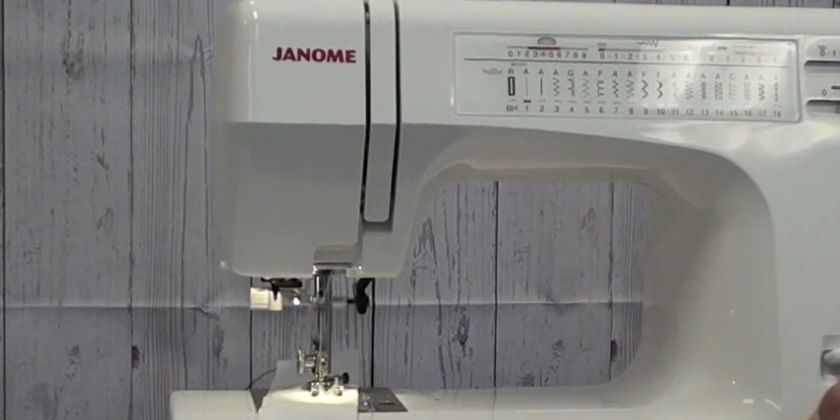
It has a max stitch width of 7mm, a stitch length of 4mm, and a max sewing speed of 860 stitches/minute, allowing you to produce reliable results quickly and with quality.
The HD5000 is a dual-voltage machine, meaning you’ll be able to use it if you move out of the US in the future, and it also features a built-in fold-down carry handle. It also has a protective hard cover for easy storage and portability.
A few features are missing, such as a locking stitch button, twin needle guard, and knee lift. However, these are not dealbreakers for most of us.
Despite its seemingly limited number of stitches (18 to be exact), the stitch quality produced by the HD5000 is second to none.
In terms of accessories, you get a lint brush, a quilting bar, a seam ripper, a spool pin felt, large/small screwdrivers and spool holders, and an additional spool pin.
Pros
- Detailed instruction manual.
- Easy to operate once setup is complete.
- Good-quality stitches were produced.
Cons
- Noisy operation compared to other machines.
- Needle threader requires some practice and patience.
- Knobs are a little hard to turn for elderly users.
Things to Consider In An Auto Upholstery Sewing Machine
Below are some critical factors you must consider before choosing a sewing machine for auto upholstery.
Design/Construction
The design and construction of a sewing machine for auto upholstery are significant aspects that should not be taken lightly. The machine must be robust and sturdy, crafted to withstand the rigors of heavy-duty sewing.
The construction material, usually metal, is crucial in determining durability. A machine with a hardy frame is more likely to endure the test of time, tackling thick, tough fabrics with aplomb.
The overall design matters, too. Some machines boast ergonomic designs that not only enhance user comfort but also enable maneuverability.
Additionally, factor in the size and weight of these machines. A compact, lightweight model would be ideal if you’re frequently on the move. However, never compromise durability for portability.
Thread Type And Thickness
The thread type and thickness are critical factors in upholstery sewing. Much like the right needle, the appropriate choice largely depends on the fabric you’re dealing with.
A durable thread like nylon or polyester is typically preferred for automotive upholstery. These threads resist UV rays and moisture, making them suitable for a car’s interior, which is often exposed to sunlight and may occasionally get wet.
Nylon thread is strong, flexible, and has a high abrasion resistance, making it perfect for heavy-duty stitching. However, it’s not as UV-resistant as polyester thread. So, if the upholstery is likely to be exposed to a lot of sunlight, polyester may be a better choice as it retains its strength and color despite prolonged UV exposure.
The thread size/thickness, gauged by a number system similar to needles, also plays a significant role.
Heavy fabrics typically require a heavy-duty thread (size 69 or 92), while you would need a thinner thread (size 33 or 46) for lighter materials.
Stitch Length And Width
The stitch length and width in auto upholstery sewing machines determine your seam’s strength, flexibility, and appearance. The stitch length refers to how far the needle moves forward each time it makes a stitch. In other words, it’s the distance between individual stitches.
For most upholstery projects, a medium stitch length, typically 2.5mm to 3mm, works well. A shorter stitch length may be used for delicate or lightweight fabrics, while a larger stitch length could be suitable for heavy or thick materials. However, it’s worth noting that while longer stitches might speed up your sewing, they tend to be less durable.
The stitch width is only relevant for zigzag and decorative stitches, which dictate how far the needle moves from side to side while creating the stitch.
In the context of upholstery, a narrow stitch width can help reinforce seams, while a wider stitch might be used for decorative topstitching or when working with stretchy fabrics.
Motor Power And Speed
A powerful motor allows the machine to handle thicker, more resistant materials. Generally, domestic sewing machines provide sufficient power for light upholstery work. But if you’re dealing with heavy-duty materials such as leather or canvas, you might need a sewing machine with a stronger motor.
On the other hand, a higher motor speed enables faster stitching, which is ideal for larger projects or commercial use. However, a machine that offers variable speed control is preferred for intricate work or beginners.
Walking Foot
A walking foot is an attachment used with a sewing machine. It has a set of feed dogs that work with the sewing machine’s feed dog to grip the layers of fabrics from both the top and the bottom, helping to prevent one layer from moving faster than the other.
This is particularly beneficial when dealing with slippery or stretchy materials or matching patterns or plaids. The walking foot also reduces puckering, often an issue with lighter or finer fabrics.
Reverse Stitching
Reverse stitching is a crucial technique in auto upholstery. As its name suggests, it involves sewing in the reverse direction of your initial stitching line.
This is typically done at the beginning and end of a seam to lock the stitches in place and prevent them from unraveling.
The process is simple: after sewing a few stitches, you press the reverse stitch lever or button, sew backward over the initial stitches, then release the lever and continue in the forward direction.
Despite its simplicity, it plays a significant role in ensuring the longevity of the upholstery work, keeping the stitches secure even with the rigors of everyday use in a vehicle.
Adjustable Presser Foot Pressure
Adjustable presser foot pressure refers to the force the presser foot exerts on the sewn fabric. This function is crucial in auto upholstery, given the range of fabric types and thicknesses you may encounter.
The pressure with which the pressure foot presses down can often be adjusted, allowing you to increase the pressure for heavier fabrics like leather or decrease it for lighter, more delicate materials.
There will usually be a knob, screw, or electronic setting on the sewing machine to adjust the presser foot pressure. Turning or adjusting this control will change the amount of downward force the presser foot applies.
A higher pressure will ensure the fabric feeds through more forcefully, which can be helpful for thick, stubborn materials. On the other hand, a lower pressure can prevent lighter fabrics from puckering or stretching.
Bobbin Size And Type
Bigger bobbins can hold more thread, which means fewer interruptions for changing the bobbin during large projects.
The bobbin size must be compatible with your sewing machine, as each machine is designed to fit a specific bobbin size.
There are different types of bobbins, such as plastic and metal. The type of bobbin used can affect the tension of your stitches.
For instance, metal bobbins are heavier and can create more tension than plastic ones. Using the bobbin type your machine is designed for is crucial, as using the wrong type can lead to thread jams or other issues.
Moreover, bobbins come in different styles, including top-loading and front-loading bobbins.
Top-loading bobbins are loaded into the machine from the top, usually via a slide-off or hinged plate. On the other hand, front-loading bobbins are inserted into a bobbin case, which is then inserted into the machine.
Budget
The price spectrum of these machines is broad, ranging from the modest and affordable to the lavishly expensive.
A higher price tag does not always equate to a better machine. Instead, it is the relevance of the features to your specific needs that counts.
For instance, a professional upholsterer might require a heavy-duty machine equipped with a variety of stitches and capable of handling thicker fabrics and thus may be willing to invest more.
Similarly, a beginner or hobbyist may seek a more straightforward, user-friendly machine that suits their learning curve and budget.
Best sewing machines for auto upholstery – FAQs
Can You Sew Car Upholstery?
Sewing car upholstery is something a relatively handy DIYer can take on. While it may require some patience and a little knowledge, the result — a fully customized piece of seating for your vehicle — is absolutely worth it!
To begin with, familiarize yourself with all of the items needed for successful car upholstery sewing: thread (both standard cotton or heavier nylon), fabric (vinyl or leather) as needles designed for heavy material tearing through the thematic surface, scissors, measuring tape, hammer, pins, tacks or staples and a pair of pliers.
Make sure that any fabric stocked has enough durability before using it. For example, Vinyls are standard options because they’re tightly woven but relatively thin enough to accommodate tight curves in vehicle interiors without creating too much bulk.
What Type of Sewing Machine Do I Need For Leather?
When working with leather, the type of sewing machine you need may depend on your experience and desired outcome.
Using a domestic sewing machine should suffice if you’re just getting started.
But investing in an industrial-grade straight stitch machine is best if you’ll be taking on more advanced projects involving thicker and heavier materials soon in the future, such as shoes or bags. These machines tend to be sturdier because they usually feature more powerful motors, making them well-suited for more rigid fabrics.
Can You Sew Auto Upholstery With a Regular Sewing Machine?
Yes, sewing auto upholstery with a regular sewing machine is possible.
In most cases, basic upholstery projects such as recovering seats or making seat cushions can be done using a regular sewing machine.
But if you’re looking for something more heavy-duty, then I would recommend investing in an industrial sewing machine that can handle heavier fabrics – this is especially true for materials used in auto upholstery, which can often feature thicker textures than other types of fabric due to their durability requirements.
What Size of The Needle Is Required for Auto Upholstery?
For lightweight fabrics such as nylon or polyester twill blend (think car seats), consider using needles in sizes 9 or 11. Mid-weight fabrics like wool blend suit needles sizes 11 or 14 and heavyweight materials like leather call for needle sizes from 14 – 16. Extra heavyweight fabrics such as canvas require larger-sized needles – between 16 – and 18 – to make sure they don’t cause too much strain on the machine itself while stitching.
Generally speaking, use needles slightly finer than the fabric thread you intend to use. This helps prevent fraying, breakage, and potential damage to your machine when trying to sew thicker fabrics.
What is The Best Material to Reupholster a Car?
Vinyl fabric provides excellent value for your money as it’s more cost-effective than many other fabrics. It also features good durability and longevity. It won’t tear or wear down quickly due to its rigid but pliable texture. Also, with regular maintenance, it can look almost brand-new forever!
But what makes automotive upholstery vinyl really stand out is its built-in UV protection—in fact, this fabric will protect against fading caused by direct sunlight over long periods better than most other materials available on the market today. Its superior performance against moisture also means you won’t have to worry about mold or mildew growing on your car seats after extended exposure to humid climates or bad weather conditions!
Do You Need a Heavy-Duty Sewing Machine to Sew Leather?
The short answer is yes. You do need a heavy-duty sewing machine to sew leather. But the good news is that you can make any good-quality home sewing machine to sew leather perfectly by making a few simple modifications.
When working with leather, your sewing machine must be equipped with an additional presser foot for projects like this one; this will help keep your stitches even and consistent throughout the process.
Also, swap out your regular needle for one designed specifically for heavier fabrics like leather. You may have to go up a size or two depending on the thickness of your material, too. Finally, set up a special stitch length and the tension knob so that everything works together smoothly when working with such heavy-duty fabric.
